Taking a taxi in Bangkok is a crap shoot. While the current flag fall of 35 baht (about USD $1.10) is among the cheapest in the world (and long overdue for a raise IMHO – it’s been the same for years), the fleet that patrols Bangkok’s storied streets is…uneven, at best. Most guide books and travel websites have warnings about taxi scams, and the longer you live here the more likely you are to know someone who’s had an experience so bad they’ve sworn off taxis forever…but soon find themselves white-knuckled in the back seat again, because, well, what else are you going to do? But now, Bangkokians do have an alternative – several in fact: Uber and GrabTaxi. They offer a similar service, but have several important differences. I’ve used each a few times and this is how they compare.
But first, to be honest, most of the time you get a taxi in Bangkok – maybe 75% – you’ll have a completely boring, uneventful ride, which is how it should be. That is, if you get a taxi. Drivers have no problem refusing to take you if they don’t want to go where you want to go due to traffic, the possibility of a gullible fare who they can scam, or simple laziness. It’s technically illegal, but getting into an argument with a taxi driver is not a very good idea, as some have tragically found out. If you do happen to get a taxi, there’s a high percentage he’ll drive like a maniac; reek of body odor and/or booze; blare his music way too loud; have a car that’s held together by tape; doesn’t know how to drive properly; or try to scam you with the old “meter no work” trick. And don’t even get me started on the lack of seat belts. Like I said – a crapshoot.
But now with these two services, you can get safe drivers, nice cars, (usually) good service and the peace of mind that you’ll arrive at your destination safe and sound.
Uber was formed in San Francisco in 2010 and has fought long, hard battles to stay in business. It’s basically a private car service that you call with a smartphone app using your GPS location. There was a lot of skepticism when it launched in Bangkok a few months ago but so far it seems to be tearing up the social medias as it irons out the kinks during its first few months – not uncommon for a new service in a new market.
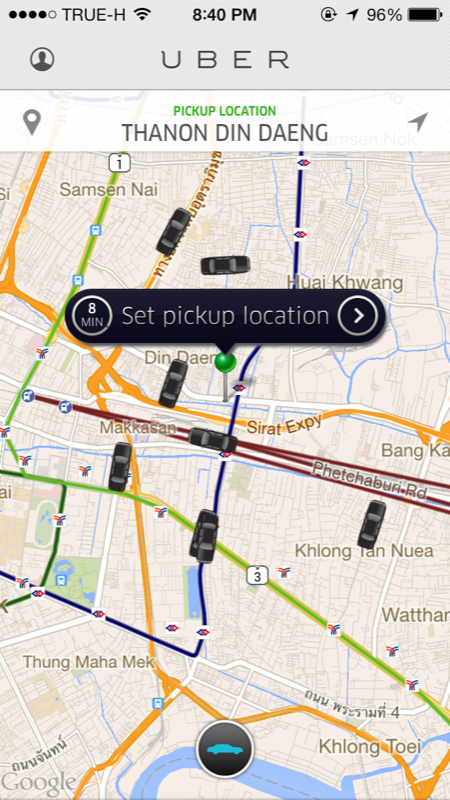
The Uber iPhone app.
The good thing about Uber is that you don’t have to use cash – they have your credit card, and when you get to your destination you say thanks, step out of the car, and you’re done. (Although I can’t find any information on whether you should tip the driver – anyone?) The cars are nice – maybe not as nice as the website leads you to believe, but they’re new, clean, and provide a smooth ride. When you place your order, you get a phone call from the driver about 15 seconds later confirming your location and giving you an ETA. You get the license plate number, a picture of the driver, his rating from other customers, and you can follow the progress of your car on a little map on your phone, so you know when to put your shoes on and head downstairs. It’s all very slick.
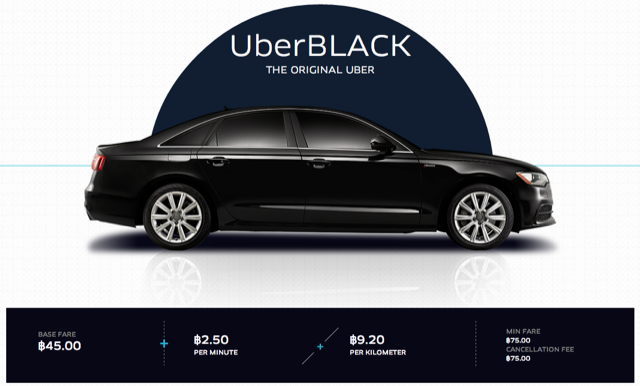
Uber cars in Bangkok aren’t actually this shiny. Actually, no cars in Bangkok are this shiny.
Costwise, Uber is a bit pricey. As you can see below, the receipt I got via email after a trip the other night was 147 baht – plus I tipped the driver 40 baht, for a total of about 190 baht. A regular taxi would have been about 75 baht or so. But, my wife and I had a few too many margaritas and were tired after a long dinner with friends, so it was worth it.
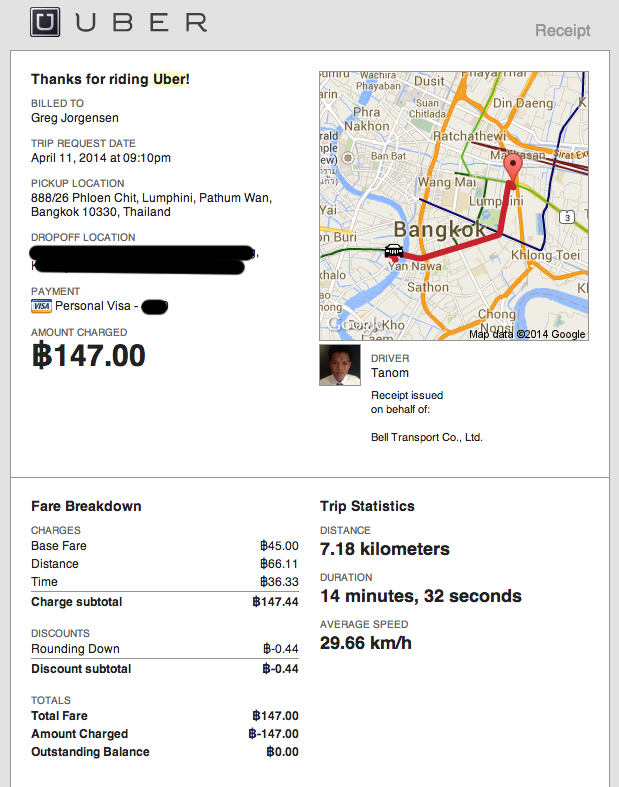
Oooh, slick.
Now on to GrabTaxi. This one was founded in Malaysia a few years ago, but instead of having its own private fleet of cars, it uses the existing taxi network to source its rides. The app works in much the same way as the Uber app does, but with one interesting difference – you can enter in how much you’re willing to tip. This adds an extra social element to the whole equation – enter in 20 baht and you miiight get a taxi. Enter in 1,000 baht and you’ll have them racing to pick you up. When you order you have to think: how badly do I need a taxi right now? In addition, from what I’ve heard all of the taxis are vetted and trained, so you the chances of ending up with a driver with a death wish are pretty slim.
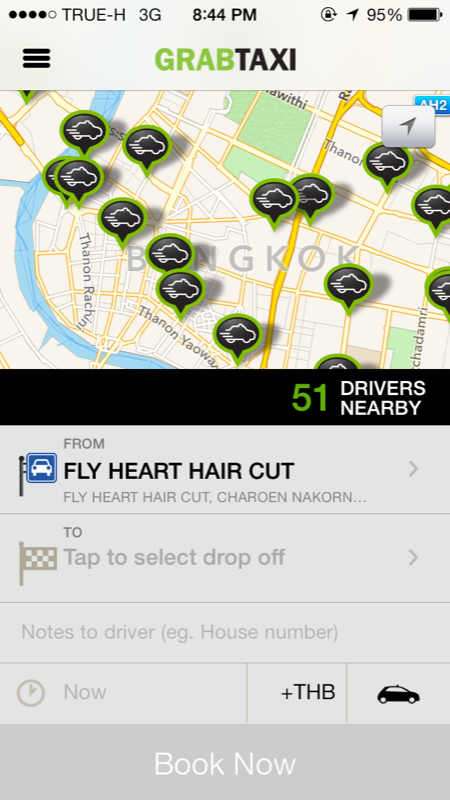
Yes, the pickup location was chosen ironically for this example.
As with Uber, you get a call when a driver accepts your bid, watch as his little icon gets closer to you, and have the license plate number, picture, and rating of the driver. Because GrabTaxi uses the existing taxi fleet, there are many, many more vehicles available. However, the problem of a taxi driver simply not wanting to pick you up is still there – last week I ordered a taxi and after some searching it said no taxis were available, even though I could see on the map there were several of them just a few hundred meters away. As far as I know, Uber never says no.
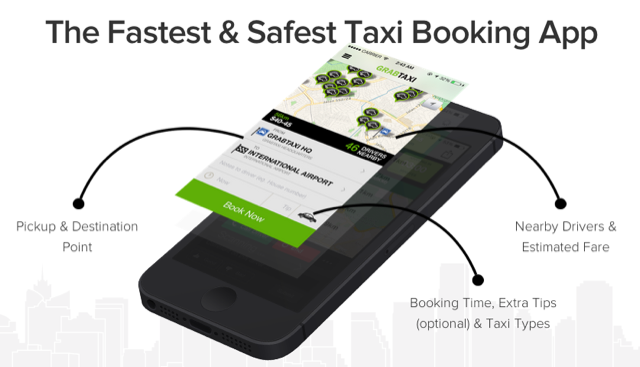
The GrabTaxi website, which is really well done.
However, the trip I booked previously worked great – the driver took me up to Chatuchak Market for the regular meter fare, plus a 25 baht service charge. He was a nice guy and practiced his English with me, and drove like a normal human. Another big selling point – you can share your trip with others, so they can follow your progress, adding an extra level of insurance to your ride
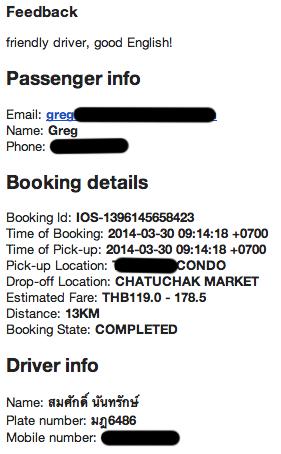
My GrabTaxi receipt.
So which one do I prefer? It’s hard to say, but I think that it comes down to this: Uber is good if you’re going out to an event and want to arrive in style, or want to treat yourself (or your sweetheart) to a nice, comfortable trip. GrabTaxi is good if you want to save a bit of money and have a better selection of potential rides. But no matter what you’re looking for, it’s great news that Bangkok’s transportation options just got a shot in the arm.


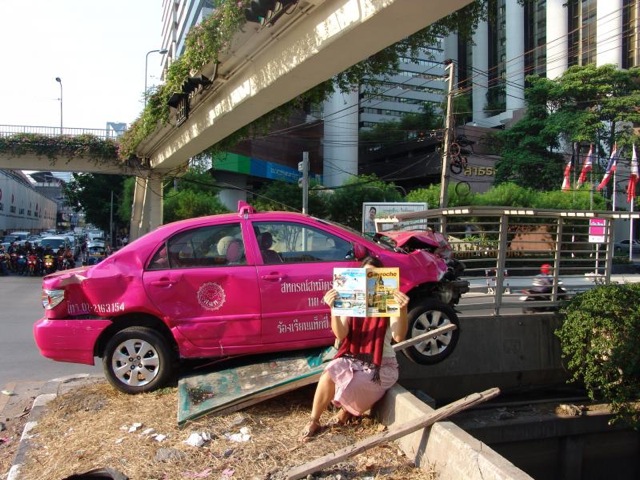
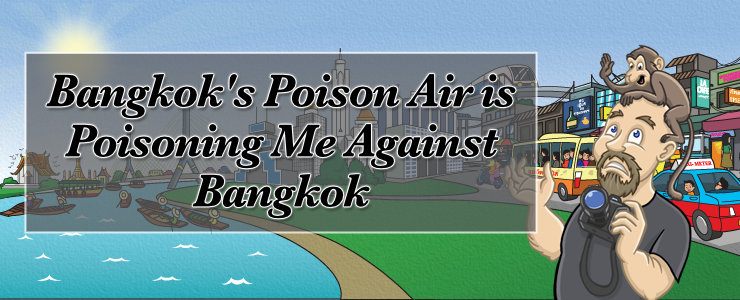
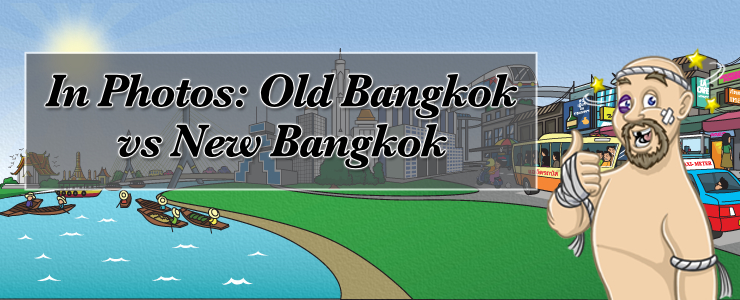
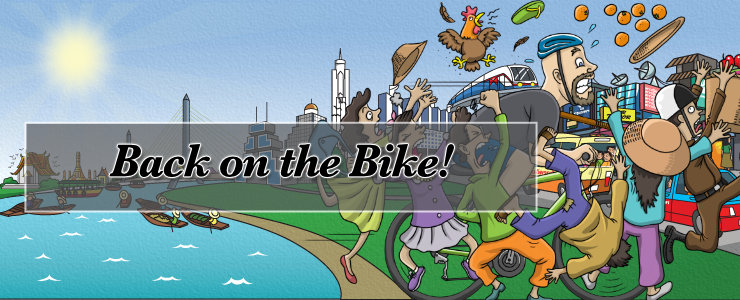
There is another one in Bangkok I’ve seen it on Facebook recently, called EasyTaxi. Haven’t tried it yet. http://www.easytaxi.com/
Hi Liam, thanks. I heard about them months ago but haven’t heard a single thing about them since. Nothing on FB, Twitter, no ads, and I don’t know anyone who’s tried them. Have you used them?
I tried Easytaxi last week. I found them to be more reliable as compared to Grabtaxi which has let me down a couple of times. With these guys, their service center called twice to make sure of the location and to make sure the taxi got there.
Thanks lwedkoong and Batholith. Interesting to see two different opinions so close together. I’ve also heard of bad experiences with GrabTaxi and Uber too – just growing pains, I think. I hope. 🙂
GrabTaxi is the best! Use their service to go the airport and drivers are polite. Tried EasyTaxi once and it was useless- waited over 5 minutes for app to say there were no taxis:(
I’ve tried Easy Taxi ans it’s useless. Waiting too long and no taxi around me (Sukhumvit 18)
Hi Greg, I would like to tell you more about Easy Taxi. We are on FB : https://www.facebook.com/EasyTaxiThai and twitter.
Have a good ride.
[…] the beached (there are not any right now), but anything that challenges the status quo will do! Review of Uber vs Grabtaxi in Bangkok by Greg Uber Phuket page on their […]
How did you deal with the language barrier? Most Thai taxi drivers barely speak any English.
I tried Uber/GrabTaxi in Bangkok and spent over 20mins trying to explain my location before giving up.
Well, I think the luck of the draw. Some Uber drivers speak great English, most are okay, a few none at all. Taxis are a different story although sometimes you’ll get one who speaks good English too. But most of the conversations with Uber are in Thai – just makes things easier. 🙂
Hi Greg, I driver Uber & Grab in BKK,Thailand. Now I have Car Service for travel on one days trip, Contract to me on https://web.facebook.com/piyapong.notto, I can speaking Eng a little. Or you booking me for travel I can.
If the taxi driver calls u and u are unable to explain the location just hand over your phone to the nearest gateman or staff u find ..it will be easy then
Is Grab & Uber still activate in Bangkok?
Yes, both are still active, and have expanded their service offerings.
According to your pictures you ordered an UberBlack instead of UberX. UberBlack is 3-4 times more expensive.
Correct, but at the time of writing UberX wasn’t available in Bangkok – Uber Black was all there was.
Very helpful comparison, thank you! I’ve used Uber a lot in SE Asia but was curious about Grab. Cheers.
Thanks Greg. Grab’s service has changed a bit since I wrote this – more options now, but their big weakness is still that they use local taxis, which are unreliable in the best of times.
I think its a matter of preference and expectations. Its great that there are competitive offerings. Uber is more professional hands down. From the app to the overall experience while Grab is essentially the middle man and thats all they’re aiming to be. Uber has a ranking system that the drivers need to maintain and a quality of service that they at least strive for, even with Uber X. So for my money and peace of mind I always go for Uber. With grab it all feels a little held together with gum and duct tape.
Totally agree. Like I’ve said before, Grab is a fantastic app, but their product – Thai taxi drivers – are very flawed.
The only problems I had with Grab are 1. Drivers calling me back after 15 minutes saying they want ME to cancel my booking! and 2. One time I did ‘Grabcar’ by mistake, and got a woman racing driver – worse than any taxi I ever rode.
So Grab Taxi is the one to go for in my experience – and my wife uses it sometimes for going to work in the morning at 5.40am – never failed her either.
Yeah, the quality of the driver is always the sticking point with Grab, but I’ve always had polite (if sometimes a bit lost) Uber drivers.